

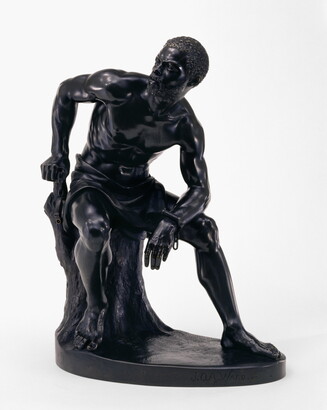
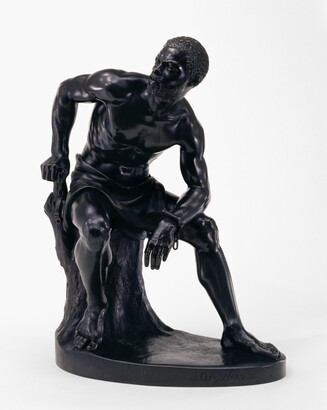
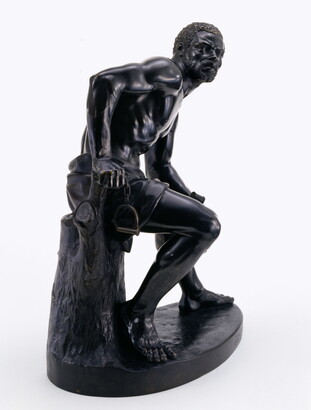
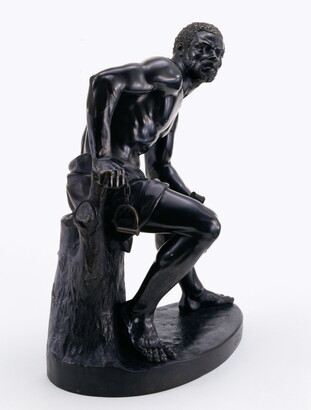
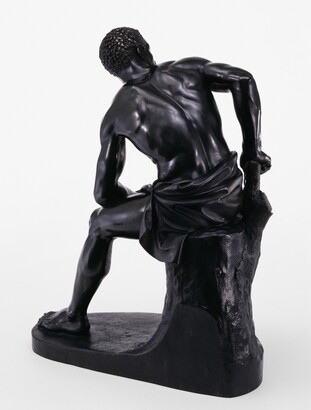

Artwork Images
Photo:
Controls
The Freedman
Object Details
-
Date
1863, cast after 1863
-
Object Type
Sculptures
-
Medium
Bronze
-
Object Format
Sand casting
-
Dimensions
19 3/4 x 14 1/4 x 10 1/2 in.
-
Inscriptions
Base, p.r. front edge, inscribed: J. Q. A. Ward. Sc\
1863
Manacle:
Across arch of manacle, inscribed: FORT WAGNER JULY 18TH 1863
Across barrel of manacle, inscribed: 54th Mass. \ Colored Vols
-
Credit Line
Amon Carter Museum of American Art, Fort Worth, Texas
-
Accession Number
2000.15
-
Copyright
Public domain
Object Description
An opponent of slavery, Ward created The Freedman shortly after President Lincoln issued the Emancipation Proclamation freeing individuals enslaved within Confederate states. Portraying a seated Black man wearing broken shackles, this work marked a new way of portraying emancipation in sculpture. Typically, 19th-century abolitionist imagery portrayed enslaved people as passive, awaiting liberation by White saviors. In contrast, Ward’s figure is someone who has actively sought out and attained his own freedom, with an upturned gaze that conveys agency and strength. Ward explained that the pose was calculated “to express not one set free by any proclamation, so much as by his own love of freedom and a conscious power to break things.”
This cast of The Freedman is unique. Of eight known to exist, it is the only one with an operable shackle and key, and the only one with a carved inscription honoring the Massachusetts 54th, a regiment of Black soldiers who served during the Civil War.
—Text taken from the Carter Handbook (2023)
Additional details
Location: Off view
See more by John Quincy Adams Ward
Tags
-
Created during the Civil War era, abolitionist and artist John Quincy Adams Ward’s shiny, smooth, black bronze sculpture The Freedman was inspired by President Abraham Lincoln’s Emancipation Proclamation. Ward created different versions of the same subject, but this almost 20-inch sculpture is meant to be viewed in the round.
Here the sculptor depicts a seminude Black man sitting on a tree stump, wearing a broken manacle on his left wrist and holding one that dangles from his right hand. The man hinges forward at his waist, slightly twisting his torso to his right. He holds his head up, staring out as if looking toward his uncertain future. He has short, curly hair that is tight, his eyes are open, and a short mustache and beard surrounds his closed lips. His left shoulder dips lower than his right, and he rests his left elbow on his left knee which is bent. His chest opens out and his hand grips a taller part of the tree stump. His shoeless left foot is completely flat on the ground, while his right heel rests on the base of the tree stump. His toes are flat and spread on the ground. He has a small cloth wrapped around his waist that drapes over the top half of his thighs.
Ward paid close attention to bodily details, seen is the anatomical accuracy of the man’s muscles and veins, and particularly in the hands and feet. The artist wanted to be sure to capture this figure with as much dignity as possible, and avoided including any stereotypes that were so often used when depicting Black Americans in the past. Ward modeled this sculpture from life and this work is often acknowledged as the first and most accurate sculptural representation of a Black person.
The sculpture sits on a bronze, oval base that is a little over 14 inches long and is about a half inch high. The artist inscribed his name, J.Q.A. Ward, on the raised edge under his left foot.
Part of this artwork, but not attached to the figure is a shiny brass key. It lays flat on its side, directly on the podium, a few inches from the sitter’s left foot. The key is roughly 2.5 inches long, and a little under 2 inches wide. The key is a narrow cylinder with two flat wings that have holes in the center. It unlocks the manacle that is still on the man’s wrist.
Because of Ward’s masterful execution and powerful message, this small sculpture made a big statement then and continues to do so today.
-
Why do artists create memorials?
How can an artwork help a community remember and/or honor an individual or group?
What historical events might prompt an artist to sculpt a memorial or monument?
What can an artwork tell us about an artist’s attitudes toward a historical event?
How have artists in the United States historically treated the subject of slavery in their artwork? How have they treated the subject of freedom?
-
Grades 5–8
In 1863 during the Civil War, President Abraham Lincoln created the Emancipation Proclamation, which was meant to free slaves in the South. John Quincy Adams Ward made this sculpture to honor and symbolize that event. Students will imagine that they are the artist and are writing to a newspaper about their new sculpture. Describe how the sculpture looks (be specific). How does it symbolize the Emancipation Proclamation? Why is this sculpture important?
Grades 9–12
Art historian Lewis I. Sharp called The Freedman “the sculptural manifestation of Lincoln’s Emancipation Proclamation.” Read the transcription of the Emancipation Proclamation while looking at The Freedman. Do you agree with Sharp’s view? Why or why not? Which part of the Emancipation Proclamation does The Freedman exemplify particularly well? Defend your response by providing visual and literary evidence.
Share Educator Resources
Amon Carter Disclaimer
This information is published from the Carter's collection database. Updates and additions based on research and imaging activities are ongoing. The images, titles, and inscriptions are products of their time and are presented here as documentation, not as a reflection of the Carter’s values. If you have corrections or additional information about this object please email us to help us improve our records.
Every effort has been made to accurately determine the rights status of works and their images. Please email us if you have further information on the rights status of a work contrary or in addition to the information in our records.
Related Works
-
The Scalp, 1898
Frederic Remington
Bronze
1961.397
-
Bear Cub Grooming, ca. 1887
Paul Wayland Bartlett
Bronze
2007.7
-
Benediction, 1922
Daniel Chester French
Bronze
2005.17
-
An American Stoic, 1912
Alexander Stirling Calder
Bronze
2002.4
-
Pronghorn Antelope, 1914
Paul Manship
Bronze
1997.3.B
-
Counting Coup, 1905
Charles M. Russell
Bronze
1961.116
-
Study for a Monument to Walt Whitman, 1919-1920
John Bradley Storrs
Bronze
2001.1
-
The Broncho Buster, 1895
Frederic Remington
Bronze
1961.2
-
The Wicked Pony, 1896-1898
Frederic Remington
Bronze
1961.16









